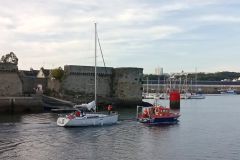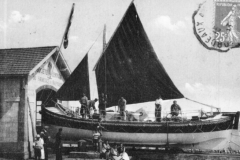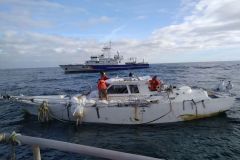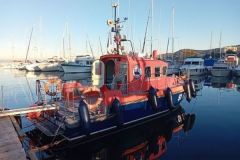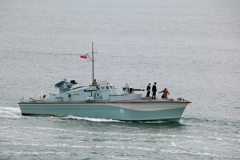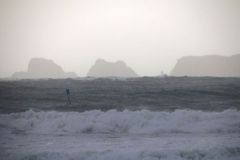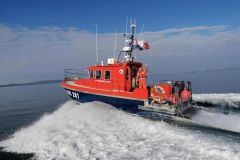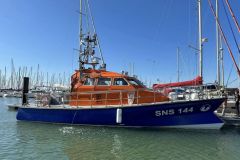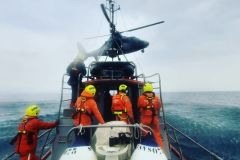Damage to propulsion, helm, discomfort of the skipper... The reasons that can lead you to ask for a tow are numerous, but the towing method will remain virtually the same in all cases.
Towing request?
In principle you will not ask for a towing service. You will request assistance from CROSS or a private tow truck. This person will propose a towing service to get you out of the situation your boat is in.

We're talking about the most common case here, an SNSM tow. Communication will be the key to the success of this operation; it will necessarily be three-way, between you, the rescue launch and CROSS in its mission to organize the rescue. The purpose of the first exchange will be to ensure the primary mission of the SNSM, the rescue of people. You will be asked, therefore, before anything else, to introduce your crew and ensure that everyone is safe and that if anyone is injured or ill, they will be brought to safety before your boat.
The boat will then be taken in charge, its characteristics will be requested (dimensions, details of the damage, weight, model, possible waterways, rudder in position ...). It is up to you to give as much detail as possible, there is never too much to facilitate a towing operation.
Drawing up a towing contract
CROSS will then ask you in a recorded communication (as in all exchanges with this authority) whether you understand and accept, among other things, that this towing service will not be free of charge. Accepting this towing by radio means establishing a "no cure - no pay" type contract with the tug, in French a contract with an obligation of result, your vessel must have been brought back safely for it to be carried out. The cost of a towing operation will depend on several factors which you can find in our article on "The cost of a tow"

Once your agreement has been reached, the launch will report to the zone to carry out the actual towing operation. Most often, the skipper of the launch (the one who steers it during the intervention) will go around your boat several times. The objective is to detect any damage that you can ignore (water ingress, broken cleat, structural weakness...) to make sure that you can hook your boat safely. During control towers, you simply have nothing more to do than keep all your crew members inside the boat, instructions will come.
Lifeguards on board
In general, one or two rescuers will be sent (swimming) aboard your boat to make sure everyone is safe (vests, harnesses), check the operation of the helm and pick up anything that may have fallen into the water, including ropes that may have come into a tug's propeller.
They will also ensure that a solid mooring point exists, which is increasingly rare. By the way, the SNSM recommends " If you have a small boat or RIB, attach one end to the bow chainplate (the ring through which you pull the boat onto its trailer), this is the strongest part of its structure, brought back towards the front of the boat it will be used to pass the trailer. "
If no point seems reliable enough, or if they feel that the bow of the boat is not safe enough, rescuers can go through the front cleats and reach the rear of the boat on winches or other cleats. The idea is that the trailer should allow the bow of your boat to be pulled as straight as possible by a "crow's-foot" trailer that will hold your boat in place.

Once everything is moored, the actual towing operation can begin. You will see the tug moving away from you, several dozen or even hundreds of metres sometimes. This is to prevent you from hitting it from behind when it loses its way. It is also the distance necessary for the elasticity of the tow to best attenuate the shock of the tug's traction on the one hand.
Stay inside the boat
He's going to get a shock when the trailer goes into tension. There is a risk that the towline will break when it comes under tension and whip violently, potentially injuring a crew member on deck. Once the trailer is under tension, you are now being towed. The rescuers aboard your boat will then be able to make some adjustments to allow towing in the best conditions, depending on the swell, the wind and all the surrounding nautical elements. Trailers can be placed at the rear of your boat (buoys, buoys, ballasted end, chain...) and will be used to slow down your boat when the tug loses momentum and to keep it in line, less inclined to hunt.
It is possible that, if there is a special need, the tug master may decide to release the towline. Don't worry, he will have contacted the rescuers on board beforehand, it is not to abandon you, it is to resume towing more safely.
Return to port
When approaching the shelter, the rescuers will stop the tow a few hundred meters away, time for your boat to lose its way and get closer to the tug. The tug will come alongside your boat to complete the manoeuvre and bring you as close as possible to a safe anchorage, a berth.
It is precisely at this point (when you have gained this anchorage) that the towing contract will be considered fulfilled. You are, then, responsible again for your boat, including its mooring.
Depending on the speedboat's equipment, you may, in some cases, be able to pay the amount of the tow to the rescuers directly by credit card. And above all, thank them... They are volunteers and have just saved you from embarrassment!





